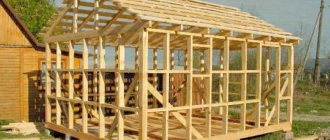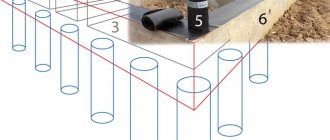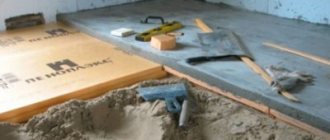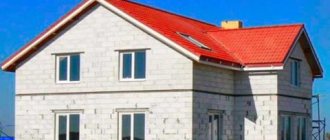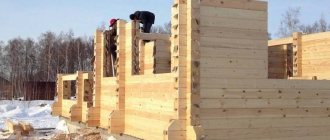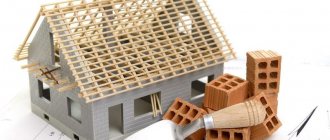What kind of cellar to build at the dacha
A modern cellar is a complex engineering structure, which is easy to see by looking at the vegetable storage facilities of users of our portal.
At FORUMHOUSE, such structures are made using nanotechnology, heavy equipment, many cubic meters of reinforced concrete, counting and laying bricks, and concrete rings. Popular are monolithic structures that resemble a bomb shelter and beautiful “hobbit holes” with a convenient entrance.
You can build a cellar at your dacha, as in the photographs above, with your own hands - but it is expensive and will take time.
It is not necessary to build such complex structures; if the task is simply to preserve the grown products until spring, an ordinary vegetable pit with earthen walls or finishing with material that every homeowner has on hand may be sufficient.
All cellars are divided into:
- underground (buried),
- semi-recessed
- ground. They are made if groundwater already lies half a meter from the surface of the earth.
The deeper the pit, the less likely it is to freeze, so in practice, owners of dachas and country houses always try to make recessed or semi-recessed structures. Let's look at these options in detail.
Overlap
If the cellar in a private house is made with your own hands, then the installation of thermal insulation of the ceiling seems unnecessary to many. This opinion is erroneous, because inside the cellar a stable temperature must be maintained within +2, +5 degrees, which allows the products to remain in their original form for many months.
If the air in the cellar warms up too much, then the provisions will instantly spoil, almost all of them. In addition, in winter, without a high-quality insulated ceiling, heat will go into the cellar, thereby increasing heating costs.
It is quite possible to make a ceiling with your own hands from wood, but how to insulate it?
- A kind of “shield” of boards is attached to the supporting beams from below. The boards can be secured with self-tapping screws or nails. Nails must be driven in in different directions, at an angle, several nails per board. It is still better to fasten it with long self-tapping screws - it will be more reliable.
- A vapor barrier film material is attached to the shield, which is necessary to prevent the thermal insulation layer from getting wet.
- The entire space between the beams must be filled with thermal insulation material. In the case of a basement, mineral wool or glass wool is usually used, which is quite affordable.
- Waterproofing is placed on the thermal insulation material. A roll insulator that can be overlapped works well. It is recommended to seal all seams with construction tape.
- The load-bearing covering is laid on top and everything ends with the installation of the floor. If the entrance to the cellar is from the kitchen or living room, then it is necessary to lay the same floor covering on the lid as in the entire room.
When do you need an underground cellar?
In-depth cellars are located entirely underground, so the composition of the soil (only clayey ones are suitable here) and the groundwater level (permissible depth - at least 2-2.5 meters) are of great importance for their construction. In a damp area with a close groundwater level and high water with a buried pit, you won’t have any troubles and will be exhausted in pumping out water - it will be right to choose above-ground structures.
ChapelenForumHouse Member
I have a cellar in the Moscow region under the kitchen floor 80 cm deep. It floods halfway during long rains and melting snow in winters with little snow. No amount of sealing helps.
The simplest option for a buried cellar is a structure with earthen walls and an adobe floor. The height from the base to the ceiling should be 1.8 m. It is allowed to add soil to raise the bottom.
The walls of the pit should not be strictly vertical, but inclined at a slight angle, then they will not crumble.
To protect against capillary moisture, it is recommended to pour a five-centimeter layer of crushed stone impregnated with hot bitumen on the bottom, and then make an adobe floor on top (about 10 cm) with the addition of small crushed stone.
Andrey506FORUMHOUSE user
Moist air always comes from the ground; moisture condenses on the cold parts of the underground. With all the ensuing consequences (dampness, mold, mildew, etc.).
How such a structure is made can be seen in the diagram.
The cellar is covered with a ceiling, insulated and covered with earth. Previously, a cellar was always placed on the pit - a building in the form of an insulated gable roof. There you can organize temporary summer storage of supplies and keep gardening tools, materials, etc. there.
In hard soils, earthen walls are sufficient for long-term use without any problems. This is a great option for a summer residence. If the soil is weak, then the walls need to be strengthened - in the Russian burial tradition, logs were used for this, now the walls are increasingly reinforced with concrete or red brick. An excellent cheap option for strengthening the walls of a cellar in a country house is sheets of used slate.
Floor
Most often, concrete is used to cover the base of the cellar. This solution is practical and durable. Often, the owners of a private house decide to leave the soil foundation of the cellar. An earthen floor has several significant disadvantages:
- winter preparations can be spoiled by worms and various insects;
- the cellar will become a target for rodents;
- The soil often contains anaerobic bacteria, during the life of which methane is released.
The floor is concreted according to a certain technology:
- First the base is leveled. This is necessary for proper installation of further layers.
- The bottom is covered with sand. This creates a shock-absorbing cushion. Usually it will rise to a height of 10 cm.
- The bulk material is compacted. Water is used for this purpose. The sand must be poured thoroughly.
- The entire bottom of the cellar is covered with plastic film. It will help stop the concrete milk that forms when pouring the solution, and will also help prevent groundwater from entering the room.
- Laying of reinforcement. The mesh has a thickness of 6 mm. Cells are usually made with dimensions of 15 cm.
- The mesh must be placed in the middle of the concrete layer.
- Pouring concrete.
- Performing finishing screed. It will be equipped 3 days after pouring the solution.
As soon as the floor is ready, you need to take care of the overlap.
Making an underground cellar step by step
It is right to start the construction of an underground cellar with geological surveys, as our user with the nickname Evgeniy G. did. Before starting to dig a pit, he ordered a study and found out that the groundwater is very far away, there is no high water, the soil is 2 meters of loam, then sand . In these conditions, you can get by with earthen walls, but Evgeniy decided to “make waterproofing, like in a swamp,” designed the formwork and filled the monolithic cellar.
You can get by with much less effort and financial costs: a FORUMHOUSE user with the nickname Zagrebin built the structure from materials that were at hand.
It is worth considering this technology step by step. To make such a storage, you need:
- Dig a pit 2x2 m (but this depends on the depth of soil freezing; if it is large, you will have to dig with an excavator;
- Weld a frame from metal pipes (these were purchased at a scrap metal collection point). In this case, the vertical pipes are not dug in and no foundation is made for them - the lower perimeter of the pipes protects them from subsidence. The pipe, which is made in the middle for fastening the shelves, stands on a metal plate 12x12 cm.
- Protect the hole by lining the inside with old sheets of slate;
- Weld the shelves. For safety, it is important to do this immediately, in an open space;
- Cover the hole with a sheet of iron, insulate it with polystyrene foam (layer thickness 50 mm), cover it with earth;
- Be sure to cover the pipes and metal ceiling with mastic to protect against rust.
- In such a cellar it is easy to arrange supply and exhaust ventilation. To do this, it is necessary to drill holes in the opposite pipes of the frame: in one near the ceiling, in the other at ceiling level. Take the ventilation outside the pit and insulate it outside - in winter this will save you from the formation of frost in the cellar.
- At the stage of backfilling the cellar, lay a corrugated cable duct for lighting wiring.
- Make a hole: weld the box and weld it to the sheet to create additional rigidity. But here you need to remember that the metal box and hatch are an excellent bridge of cold, so for the winter the hatch is insulated from above with hay or warm trash. It is better to make the box and hole out of wood.
To keep such a cellar always dry, you need to properly insulate it.
EfhFORUMHOUSE user
Either the hole had to be made deeper, or the thickness of the insulation layer had to be increased, not only in the ceiling, but also in the upper part of the side walls.
The optimal shelf sizes were determined experimentally.
- Width 50 cm (or a multiple of three-liter jars)
- The height of the first tier is such that plastic boxes of vegetables can easily fit in; the next tier is the height of a three-liter jar + 10 cm.
- The shelves are made either from boards, pre-dried and treated with antiseptics and sauna varnish, or you buy ready-made plastic modules. Life hack - hardware stores often have discounts on them.
If you need a very small cellar in the country, you can simply dig a cast-iron bathtub into the floor in the garage and insulate it well with polystyrene foam. This is what a user of our portal with the nickname ami did.
Walling
The best option would be to make monolithic concrete walls. But if you do the work in the house yourself, you will have to order ready-made concrete, since it will take too much time to create the required volume of solution yourself.
When ordering concrete, you should inform an employee of the manufacturer for what purposes the solution is intended, so that the builders add a special mixture to the solution, which will create penetrating moisture insulation.
Before pouring, you should prepare formwork from boards and bars. It is better to use planed lumber to make the structure easier to disassemble.
Important. When creating walls, you need to provide ventilation ducts, as well as install electrical wiring in advance if it is planned to be hidden.
After pouring concrete, it is recommended to pierce the surfaces of the walls with a steel rod to remove foreign air from the solution.
After about 7-10 days, the formwork can be removed, but the concrete will “stand” completely in another 4-5 weeks.
Cellar made of reinforced concrete rings
An option often used is a buried cellar made of reinforced concrete rings. Usually, two meter-long rings are lowered into the prepared pit, several rows of bricks are laid on top, and the bottom is filled. Sometimes one ring is enough.
This is what our user with the nickname slavontin did.
Slavontin FORUMHOUSE user
The ring is 1.5 meters, with formwork on top, the height is 2 meters.
The photo below shows a small cellar made of reinforced concrete rings with a diameter of two meters from our user with the nickname Mastr DV.
Here's how to make such a structure:
- Dig a hole 2.5 m deep;
- Lower the two rings;
- You can buy a ready-made lid, or you can pour it yourself (you need a thickness of 10-12 cm);
- Lay the ventilation pipe and wire under the light;
- Use a brick to raise the hole to the required height;
- Cover with soil.
Interior arrangement
Due to the lack of windows, it is always dark inside the cellar. The problem is solved by arranging lighting. However, due to increased dampness, the risk of electric shock increases. It is advisable to connect the lighting through a step-down transformer that produces 12-24 volts.
Sockets are prohibited in the cellar. The switch is installed outside it - outside. The wiring is laid superficially in plastic boxes. In places of contact with flammable materials, sheet asbestos is placed. Lamps are selected with an appropriate degree of protection, which can operate in conditions of high humidity.
Shelves are made into racks or secured to the wall with anchors. The first option is more convenient due to mobility. A place is allocated under the bin, where the harvest of potatoes and other root crops is poured. All equipment is usually wooden. Racks of shelving can be made of metal for strength.
The inside walls of the cellar are whitened with slaked lime. It acts as a good antiseptic and destroys fungal spores. For beauty, blue or other colors are sometimes added to lime.
An underground cellar is sufficiently insulated with an earthen embankment in the form of a hill. If the storage facility is above ground or semi-buried, the ceiling is insulated from the inside with polystyrene foam boards.
When building a cellar with your own hands, it is important to follow all the rules and requirements. Violation of technology can lead to destruction of the structure, and along with it, products sent for storage after harvesting will disappear.


